 Subaru Forester: Calculating total and load capacities varying seating configurations
Subaru Forester: Calculating total and load capacities varying seating configurations
Calculate the available load capacity as shown in the following examples:
Example 1A
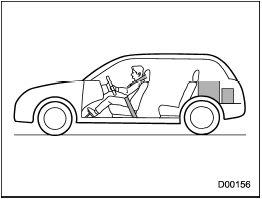
Vehicle capacity weight of the vehicle is 900 lbs (408 kg), which is indicated on the vehicle placard with the statement “The combined weight of occupants and cargo should never exceed 900 lbs or 408 kg”.
For example, if the vehicle has one occupant weighing 154 lbs (70 kg) plus cargo weighing 662 lbs (300 kg).
1. Calculate the total weight.

2. Calculate the available load capacity by subtracting the total weight from the vehicle capacity weight of 900 lbs (408 kg).
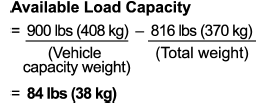
3. The result of step 2 shows that a further 84 lbs (38 kg) of cargo can be carried.
Example 1B

For example, if a person weighing 176 lbs (80 kg) now enters the same vehicle (bringing the number of occupants to two), the calculations are as follows.
1. Calculate the total weight.

2. Calculate the available load capacity.
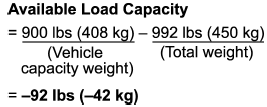
3. The total weight now exceeds the capacity weight by 92 lbs (42 kg), so the cargo weight must be reduced by 92 lbs (42 kg) or more.
Example 2A
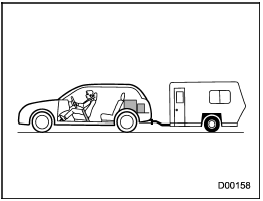
Vehicle capacity weight of the vehicle is 900 lbs (408 kg), which is indicated on the vehicle placard with the statement “The combined weight of occupants and cargo should never exceed 408 kg or 900 lbs”.
For example, the vehicle has one occupant weighing 165 lbs (75 kg) plus cargo weighing 375 lbs (170 kg). In addition, the vehicle is fitted with a trailer hitch weighing 22 lbs (10 kg), to which is attached a trailer weighing 1,764 lbs (800 kg).
10% of the trailer weight is applied to the trailer tongue (i.e. Tongue load = 176 lbs (80 kg)).
1. Calculate the total weight.
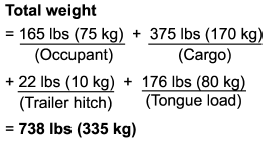
2. Calculate the available load capacity.
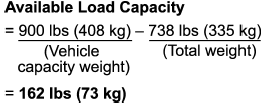
3. The result of step 2 shows that a further 162 lbs (73 kg) of cargo can be carried.
Example 2B
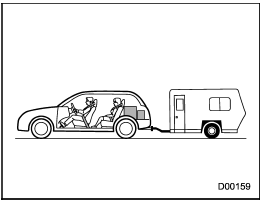
For example, if a person weighing 143 lbs (65 kg) and a child weighing 40 lbs (18 kg) now enter the same vehicle (bringing the number of occupants to three), and a child restraint system weighing 11 lbs (5 kg) is installed in the vehicle for the child to use, the calculations are as follows.
1. Calculate the total weight.
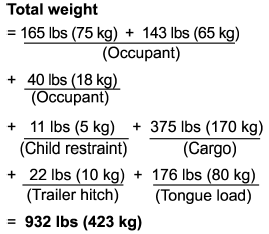
2. Calculate the available load capacity.
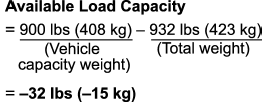
3. The total weight now exceeds the capacity weight by 32 lbs (15 kg), so the cargo weight must be reduced by 32 lbs (15 kg) or more.
 Vehicle load limit – how to determine
Vehicle load limit – how to determine
The load capacity of your vehicle is
determined by weight, not by available
cargo space. The load limit of
your vehicle is shown on the
vehicle placard attached to the
driver’s side B-pill ...
 Determining compatibility of tire and vehicle load capacities
Determining compatibility of tire and vehicle load capacities
The sum of four tires’ maximum
load ratings must exceed the maximum
loaded vehicle weight
(“GVWR”). In addition, sum of the
maximum load ratings of two front
tires and of two rear tire ...
See also:
Vehicle capacity weight
Vehicle capacity weight
The load capacity of your vehicle is
determined by weight, not by available
cargo space. The maximum load you can
carry in your vehicle is shown on the
vehicle ...
Battery
- Keep the battery surface clean and dry.
Clean the battery with a solution of baking
soda and water.
- Make certain the terminal connections are
clean and securely tightened.
- If the vehicle ...
Sunroof*
Sunroof
The sunroof can only be operated with the ignition switch in the “ON” position.
1- Open. 2- Tilt up. 3- Close, Tilt down.
To open, press the switch (1)
To stop the moving sunroof, pr ...
